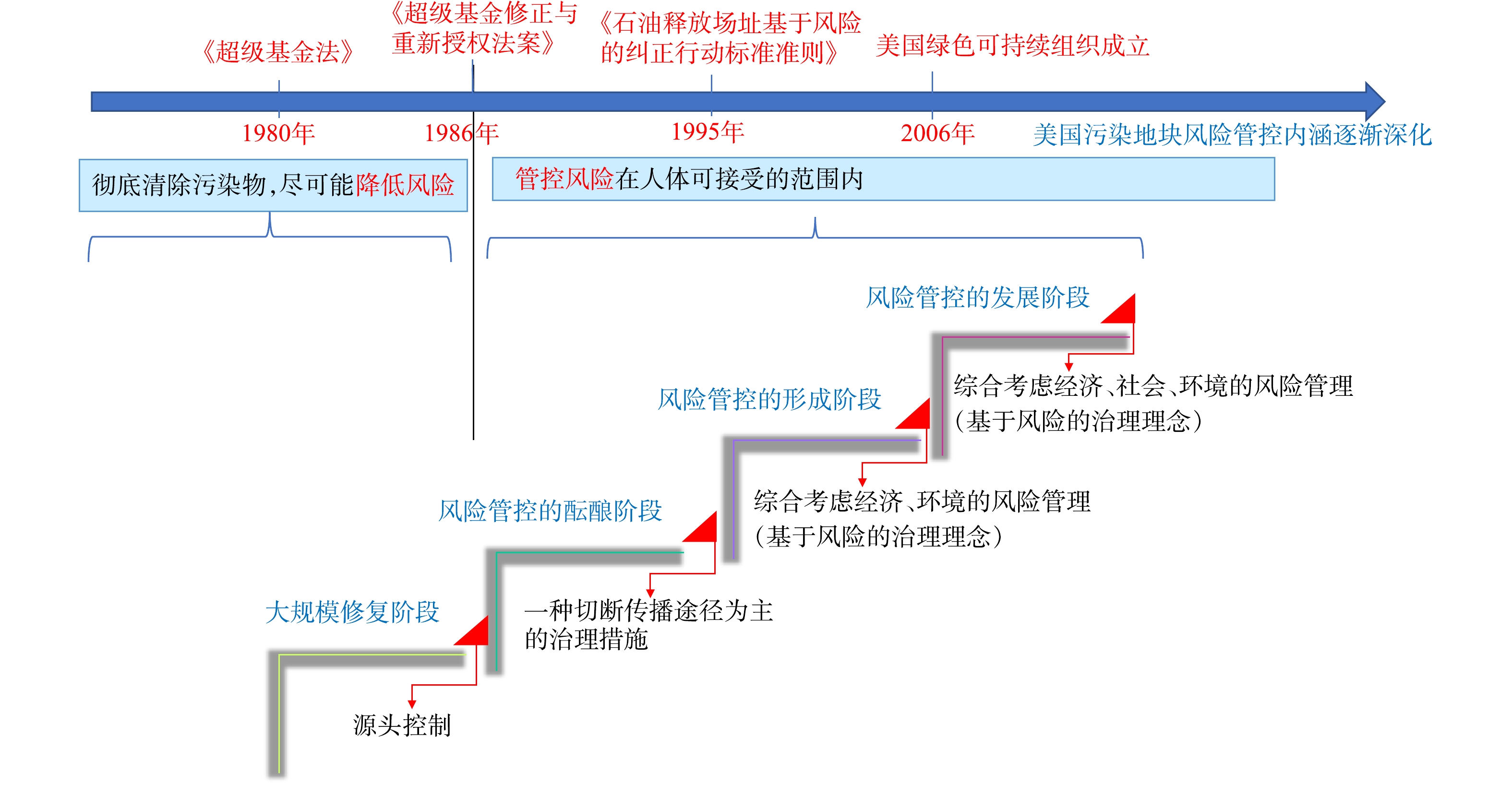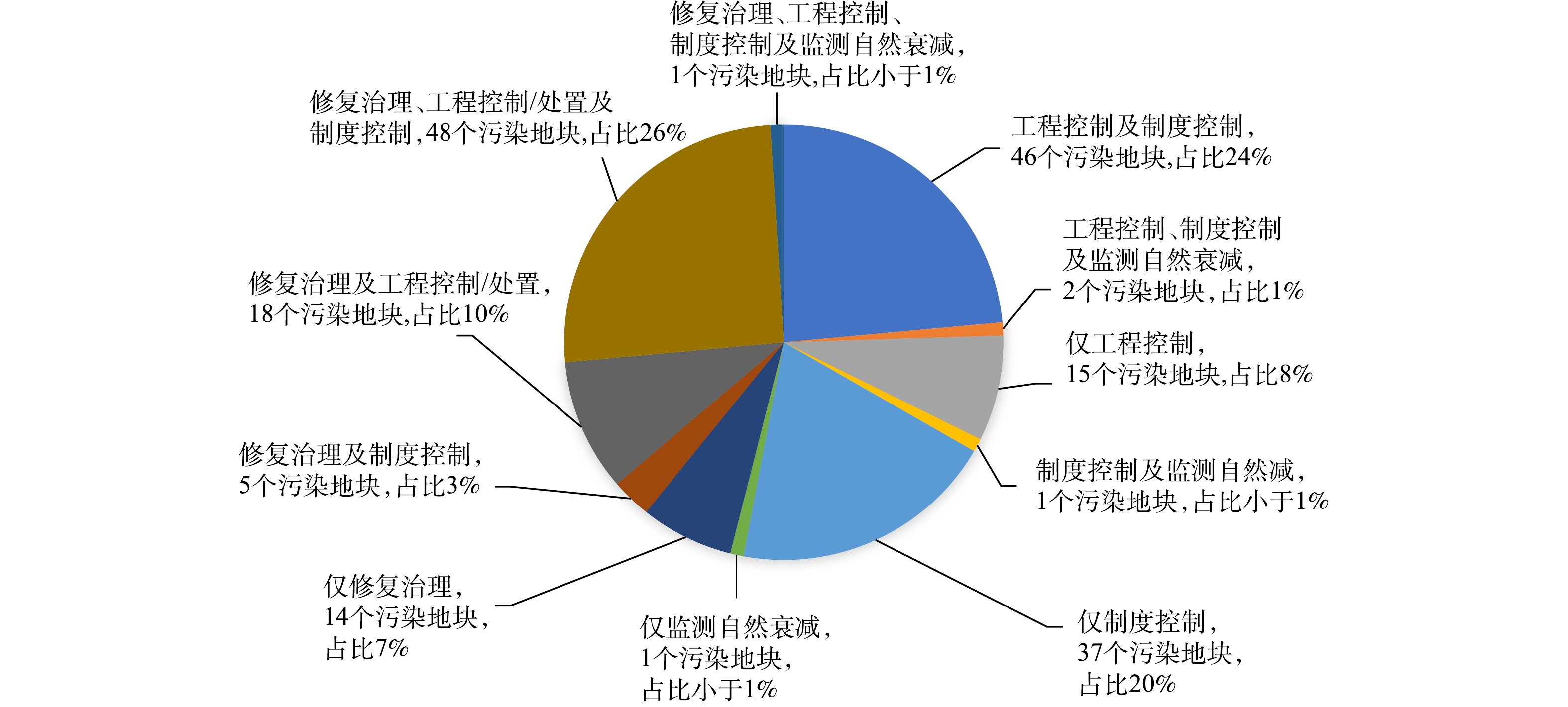-
随着我国工业企业“退二进三”改制进程的推进,产业结构加速调整,工业企业搬迁遗留了大量污染地块。利用有限的资源和资金对这些地块进行治理,成为当前土壤污染治理领域的紧迫任务。相对于污染源清除的治理方式,风险管控的成本更低、对环境的影响更小[1],是发达国家治理土壤污染的一种经济有效的选择[2]。鉴于土壤污染修复成本高昂,风险管控逐步成为我国在土壤污染防治领域的必然选择。2016年5月,国务院印发了《土壤污染防治行动计划》(后简称“土十条”),提出了“预防为主,保护优先,风险管控”的土壤污染治理原则。2019年1月1日实施的《中华人民共和国土壤污染防治法》进一步强化了该理念。在此期间,我国相继出台了一系列技术导则,初步建立了我国污染地块风险管控制度体系。然而,由于相关工作起步较晚,配套政策和具体的案例实践还有待进一步加强。
美国是最早开始污染地块治理和风险管控的国家。本文系统分析了美国环境保护署(United State Environmental Protection Agency, USEPA)污染地块风险管控的从无到有、从初级到高级的发展历程,阐述了其内涵逐渐深化、应用逐步广泛、动态管理制度逐步建立、公众参与制度不断完善的演变特征,基于此提出了明确内涵及路径、建立动态管理制度、完善全周期管理等我国污染地块风险管控的发展思路,以期为我国污染地块风险管控制度的建立提供参考。
全文HTML
-
1) 20世纪80年代初开始的污染地块大规模修复阶段。20世纪早期,美国经济和城市化的快速发展,工厂外迁导致大量污染土地遗留在城区。这些污染地块上的危险废弃物给周边居民造成了严重威胁,也引发了一些危害大、影响坏的环境事故。“拉夫运河事件”就是其中一个著名的案例[3]。该事件使美国政府意识到现有环境法规已无法应对日益严重的地块污染事件。1980年,美国国会通过了《综合环境反应、赔偿与责任法案》,目标是加速危险废弃物地块的清理并追究污染责任人的法律责任;同时,设立专门的信托基金,在责任主体无法确定时,用信托基金来支付清理费用。该法案在业界被称为《超级基金法》[4-5]。
美国《超级基金法》有2个特点:一是建立了“严格的无限连带责任制度”,这意味着任何一个责任方都可以依法被要求承担清理责任,当其无力依法承担或赔偿清理费用时,任何对其控股或参股的组织或个人都有可能成为责任对象;二是“彻底清理”,即所有治理行动都是以尽可能将污染物浓度降低到地块背景值为目标。
《超级基金法》在当时的污染地块治理和公众舆论管理中发挥了积极作用。在此之后,USEPA先后发布了危险等级系统和第一批国家优先名录,法案实施之初就有400个污染地块进入国家优先名录。1986年,第一个污染地块成功完成修复,并从国家优先名录名单中删除。这些举措帮助USEPA成功提升了政府形象和公信力[6]。但由于当时立法仓促,很多条款在内容上缺乏严密性,导致诉讼过程冗长、地块治理效率低下,《超级基金法》出台后的6年间,国家优先名录中只有1个地块成功修复。这也为事后在修复标准和追责程序上的修订埋下伏笔。
2)20世纪80年代中期至90年代中期的污染地块风险管控酝酿阶段。由于早期的《超级基金法》责任认定过于严苛,导致高成本和低效率问题逐渐凸显。根据1985年USEPA的统计数据,应列入国家优先名录的地块有1500~10 000个。这些地块的治理成本高达1 000亿~10 000亿美元[7]。而法案推行效率低下也逐渐被公众所诟病,故美国国会于1986年10月10日通过了《超级基金修正与重新授权法案》[8]。
《超级基金修正与重新授权法案》从4个方面对《超级基金法》进行了改进。一是将永久性修复与修复技术革新放在同等重要的位置,鼓励有利于降低成本、加速清理进程的创新性技术的探索应用。1989年,超级基金国家优先名录地块使用创新性技术的比例是37%[9],1994年增长到43%[10]。二是增加了进口化学衍生物税(Imported Chemical Derivatives)和公司环境收入税(Corporate Environmental Income)来补充信托基金,使超级基金由1980年的160亿美元增加至850亿美元。三是增加了州政府和公众参与度。如规定州或当地政府选择不同的治理方案,鼓励利益相关者加入和解程序。四是在修复标准方面规定,如果情况允许USEPA应优先选择彻底修复的方法,而当彻底修复成本过高时,可使用阻隔、隔断、制度控制等切断传播途径的方式[11]。但应当启动“5年回顾”,即每5年评估地块治理效果是否与预期相同,以及在治理阶段的暴露假设、毒性数据、清除水平和治理目标是否持续有效,若评估结果为肯定,则5年回顾终止[12-14]。
在此阶段,USEPA对污染地块的治理仍是优先选择永久性清除污染物,风险管控理念尚未正式形成。同时,阻隔技术和制度控制开始出现并得到一定发展。根据超级基金相关报告数据显示,1986—1995年,美国国家优先名录中使用阻隔技术的污染地块比例从28%上升至40%,采取制度管控的污染地块比例从0上升至9%。学术界将此阶段称为“狭义的风险管控”阶段,即“主动修复技术失效或者未能达到修复目标的最后的替补措施”[15-16]。本阶段即美国污染地块风险管控的酝酿阶段,1986年的《超级基金修正与重新授权法案》为该阶段的起点。
3)20世纪90年代中期至21世纪初的污染地块风险管控的形成阶段。USEPA逐渐认识到,当时的法规对地块治理的目标设定较为保守,应修改传统治理理念,以鼓励更快、更经济有效的地块治理。新的治理理念即基于风险管理的方法,通过控制污染物扩散、限制土地用途和清理污染物等方式,将风险控制在人体和环境可接受的范围内。本阶段的标志性事件是美国测试和材料协会1995年颁布《石油释放场址基于风险的纠正行动标准准则》(Guide to Risk-Based Corrective Action for Petroleum Release Sites,RBCA)[17]。RBCA包含3层风险评估的决策框架。1)一级评估。是将污染地块采样结果与国家通用的筛选值进行比较,如果样品最大检出浓度低于该通用筛选值,则判定该地块对未来人群可接受,评估工作结束。而当样品检出浓度高于该通用筛选值,并且以该筛选值依据计算的修复量较大,则开展二级评估。2)二级评估。是对污染地块进行更为详细的采样调查以获取更多地块特征参数,并基于该场地污染特征和暴露特性的筛选值计算出一个筛选值,再以该筛选值为依据计算修复目标量。如果修复量可接受,则只需进行二级评估,评估工作结束。如果修复量仍然较大,则开展三级评估。3)三级评估。是继续对评估模型参数进行替代和修正,并以此为依据重新计算修复量。随着风险评估层次的提升,修复目标越来越加客观,成本也越来越低[18-19]。
1996年,USEPA制定了《土壤筛选导则》。该导则为场地管理者提供了基于风险水平的污染地块土壤筛选水平。土壤筛选水平并非国家规定的修复标准,而是在《超级基金法》指导下,用来确定污染场地的面积、化学物质种类和暴露途径等因素,以此决定是否需要开展“修复调查”和“可行性研究”,并采取进一步的修复行动[20]。此后,美国各区和州以此为框架,根据本地污染物特征制定了适合本区域的土壤管制标准[21]。
本阶段与上一阶段的不同之处在于,其最终目的以将污染物控制在人体与环境可接受范围内[22-23],而不是彻底将污染物从地块中清除。本阶段以RBCA的出台为起点,是污染地块风险管控正式形成的阶段,强调公众参与的必要性[24-25],更关注修复技术的选择和成本效益[26-27]。
4)21世纪初至今的污染地块风险管控的发展阶段。超级基金管理模式解决了土壤污染修复治理的资金来源问题。然而,由于污染场地及设施所有者需要负担土壤修复的连带责任,造成人们尽量避开带有污染问题的土地开发。为此,2002年,美国提出了“棕地开发”的土壤污染管理模式,为未得到有效开发的污染地块提供各种补贴和政策优惠。同年,美国国会通过《小企业责任减免与“棕地”复兴法》,继续扩大联邦政府对州政府地块治理的财政支持,并且减免周边土地所有者及未来购买者的责任。2005年8月,美国允许向合格的“预期诚信购买者”提供“棕地”贷款。此举推动了棕地再开发和利用[28],当年便吸引近34亿美元的私人资金进入棕地再开发[29]。
在鼓励棕地再利用、促进土地可持续发展的同时,美国也开始探索绿色地块治理策略。其中一个重要事件是2006年美国可持续修复论坛成立,并陆续发布《可持续修复白皮书》《可持续修复框架》[30]《修复行业足迹分析和生命周期评估导则》[31]《开展修复项目可持续评估的方法》[32]《超级基金绿色修复战略》[33]《绿色修复标准指南》[34]。这些文件推动了可持续发展的理念逐步融入美国污染地块风险管控中[35-36]。本阶段风险管控的主要特点是选择恰当治理策略的同时,减少温室气体排放、能源消耗,促进社会可持续发展,同时也更加强调利益相关者参与地块治理的必要性[37],为污染地块风险管控的发展阶段。美国开展污染地块可持续治理较早,相关系列框架导则也较完善,对于带动欧美其他国家可持续修复工作具有指导意义[38]。
-
1)污染地块风险管控内涵逐步深化。笔者将污染地块的风险管控概念分为狭义和广义。其中,狭义的风险管控指当修复失效或未达到预期修复目标而采取的临时地块治理措施,通常指切断传播途径,其实质为地块治理措施;广义的风险管控指综合考虑经济、环境因素,后期融入可持续性发展等理念,将污染物风险控制在人体和环境可接受的范围内而采取系列工程措施和管理措施的总和,这既是一系列地块隔断的治理措施,也是一种基于风险的地块治理理念。因此,酝酿阶段的污染地块风险管控属于狭义范畴,形成和发展阶段的风险管控属于广义范畴。从美国污染地块风险管控的经历来看,是内涵逐步深化的过程(见图1),广义和狭义的污染地块风险管控区别与联系见表1和表2。
2)风险管控及管理措施比重逐渐升高。根据1993年的美国超级基金报告中的数据[39],1982—1991年,国家优先名录中有676个地块的治理技术属于对污染源的控制(见图2)。其中,采取修复治理措施的污染地块418个,占比62%;采取工程控制/处置措施的污染地块250个,占比37%,采取制度控制、长期监测和搬迁等措施的污染地块8个,占比1%。工程控制、制度控制、监测、搬迁等切断传播途径的治理措施属于狭义的风险管控,故在本阶段,采取狭义风险管控的污染地块共258个,占比38%。
根据2017年的美国超级基金报告中的数据[40],2012—2014年,国家优先名录中有188个地块的治理技术为对污染源采取的治理技术属于对污染源的控制(见图3)。在这一阶段,很多污染地块用的是组合技术,其中,采取修复治理措施的污染地块14个,占比7%;采取治理修复及制度控制组合措施的污染地块5个,占比3%;采取治理修复及工程控制/处置组合措施的污染地块18个,占比10%;采取治理修复、工程控制/处置及制度控制组合措施的污染地块48个,占比26%,采取治理修复、工程控制/处置、制度控制及监测自然衰减组合措施的污染地块1个,占比不到1%;采取工程控制/处置及制度控制组合措施的污染地块46个,占比24%;采取工程控制/处置、制度控制及监测自然衰减组合措施的污染地块2个,占比1%;采取工程控制/处置措施的污染地块15个,占比8%;采取制度控制及监测自然衰减组合措施的污染地块1个,占比不到1%;采取制度控制措施的污染地块37个,占比20%;采取监测自然衰减措施的污染地块1个,占比不到1%。因此,在本阶段采取狭义风险管控的污染地块共116个,相对于1982—1991年的38%,占比上升至55%。由于场地条件较复杂的地块才会被列入国家优先名录,大部分“棕地”未被列入国家优先名录,所以实际上在美国污染地块治理中采取风险管控的比例应高于上述统计数据。在美国超级基金立法几年后,风险管控比重才得以明显提高,这一方面说明了政策的滞后性,另一方面也表明其推广与公众接受度及配套政策密切相关。
此外,1982—1991年间,还没有制度控制与工程控制相结合的案例,而2012—2014年的数据显示,制度控制与工程控制相结合的案例占比24%,即制度控制已逐渐成为工程控制的补充措施。
制度控制和监测自然衰减属于污染地块风险管控的相关管理措施,二者总体呈现增长趋势(见图4)。作为风险管控的辅助管理措施,制度控制在1995年之后的几年呈现一段快速增长期,表明1995年RBCA和《土壤筛选导则》等政策得以有效实施。监测自然衰减在1995年也出现了明显拐点且比重快速上升,在这之前比重几乎为0。USEPA长期监控数据表明,在对敏感区域的最小生态干扰、减少能源消耗、降低产生废物以及减少地块治理时间和费用方面,监测自然衰减比修复治理具有更多优势[15, 41],故USEPA对此措施采取开放态度。
3)动态全过程制度逐步建立。由于污染地块风险管控通常需要将污染物控制在原地,需要对污染地块进行长期管理,所以,USEPA逐步建立并完善优化审查制度和适应性场地管理制度。
适应性场地管理是由美国国家科学研究委员会于2003年提出的一种管理策略,被描述为综合考虑污染场地水文地质、治理技术、社会需求等综合因素,对复杂污染场地进行全面、灵活、迭代的管理方法[42]。根据适应性场地管理方法,用于修订补救策略的管理措施包括修改补救活动目标、技术不可行的ARAR豁免,以及更大风险ARAR豁免、替代浓度限值、地下水管理区、地下水重新分类、低风险地块结案等。ARAR全称为Applicable or Relevant and Appropriate Requirement,中文为“适用或相关和适当的要求”。ARAR是为了确保选择的场地治理方案符合美国的环保法律要求,又称为“其他法律的顺从手册”。
修改治理目标是基于特定的现场条件下可以使用备选治理目标的一种方法。特定条件指污染源已得到有效控制,污染物降解浓度稳定下降、无潜在受体或无潜在传播途径等。该方式已被美国科罗拉多、南卡罗莱纳等州采用[43-44]。技术不可行的ARAR豁免最初是指在地下水治理中若遵守ARAR在技术上不可行,则可实施ARAR豁免,后来该方法也用在土壤、沉积物、地表水的风险管控中[41]。更大风险豁免是指,若遵守ARAR将导致对人类健康和环境的造成潜在的更大风险,则可实施ARAR豁免[23]。替代浓度限值是在特定情况下提供替代清理目标的管理方法。它提供一种基于风险的污染物浓度限值,在此限值内在不会对人体健康或环境受体造成重大危害[43]。地下水管理区是一种对地下水的特殊管理方法,当某污染的地下水无法满足特定分类时,可按一定要求通过阻隔和制度控制防止污染扩散到地下水管理区以外[45]。地下水重新分类是美国州政府向国家管理机构提出的一项申请,要求改变特定地下水和(或)含水层的名称,以便更准确地反映该地下水当前和潜在的可利用度或脆弱性,对地下水的重新分类因州而异,地下水重新分类通常与地下水使用限制、土地使用契约和其他制度一起使用[46]。低风险场地结案是指地块满足特定标准则可以将场地认定为低风险,给予结案[47-48]。根据2017年ITRC对美国50个州做的问卷统计,美国近40个州在污染地块治理过程中对治理方案进行过修改[49]。
优化审查是适应性场地管理的重要组成部分。USEPA在20世纪初就开始使用该方法用于污染地块治理。2012年9月,USEPA出台《将超级基金的优化实践从现场评估扩展到现场完工》,将基于风险的决策过程进行优化审查,并扩展应用到污染地块治理的所有阶段[50]。近年来,地块治理全生命周期的优化审查得到广泛应用。通过该策略,还可以辅助管理者将利益相关者的信息记录下来,激发利益相关者的参与热情。根据USEPA网站公布的数据,截至2020年5月,美国成功实施优化审查的案例达到150个。ITRC网站上公布了美国16个州较为典型的优化审查案例,供各州参考。
4)公众参与制度逐步完善。自1986年美国国会颁布的《紧急规划和社区知情权法》将公众扩大到包括政府、企业、社区组织、非盈利组织以及任何潜在的未来合作伙伴之后,USEPA逐步建立了一套完善、切实可行的污染场地公众参与模式[51]。根据《超级基金法》,USEPA有以下义务:定期披露场地治理相关信息;接受社会公众的意见并向其解释环保署的行为及相关依据;提供与项目有关的公众出版物或项目说明;为公众参与过程提供技术支持[52]。美国公众参与制度鼓励利益相关方广泛参与到土地规划过程,推动了地块治理和城市更新。
-
当前,我国污染地块治理处于重大历史机遇期。一方面《中华人民共和国土壤污染防治法》及相关导则初步建立了我国风险管控的基本制度;另一方面也开始探索绿色可持续风险管控。美国的经验,对我国下一步推动污染地块治理进程具有一定的参考意义。
1)明确内涵及路径,实现弯道超车。从美国污染地块风险管控的几个阶段来看,由狭义到广义、从初级到高级这一不断深化的过程,每个阶段都有自身的发展特征及内在规律。相关经验可助我国明确污染地块风险管控所处阶段,从历史演变视角为我国提供弯道超车的机会。从我国目前的发展来看,风险管控理念刚刚形成,应积极推动可持续风险管控的相关工作。鉴于我国当前处于多期叠加阶段,面临问题相对较多、情况更为复杂,建议加强对风险管控有关问题的研判,厘清相关内涵、明确当前所处阶段,吸收国外成熟经验,加快技术创新,推动我国污染地块治理弯道超车。
2)建立动态管理制度,强化示范推广。美国的污染地块风险管控这一长期制度是在发展中逐步建立和完善的,并且非常注重总结并吸收实践经验。我国多数污染地块由于生产历史较长、生产产品随市场迭代较快、早期管理不规范及环保措施不严等原因,导致其污染状况复杂,而风险管控的方式决定了对其管理必然是一个长期过程。因此,应建立污染地块长期管理制度,积极探索灵活的、动态调整的管理方式,加快推进风险管控的试点示范研究,定期对污染地块风险管控的效果进行监测和评估,及时对成功经验进行复制推广,根据技术的使用和发展情况及时对风险管控措施进行优化调整,从而保障我国污染地块风险管控效果。
3)完善全周期管理,注重公众参与。早期的美国自适应场地管理、优化审查策略虽然侧重于地块治理阶段,但是随着经验的积累,逐步将管理方法贯穿地块治理全生命周期,并十分注重与利益相关者之间的风险交流。我国应积极总结污染地块风险管控经验,根据国情尽快建立针对污染地块治理全生命周期的管理体系,尽快出台鼓励利益相关者参与污染地块各阶段的管理办法。






 下载:
下载:





